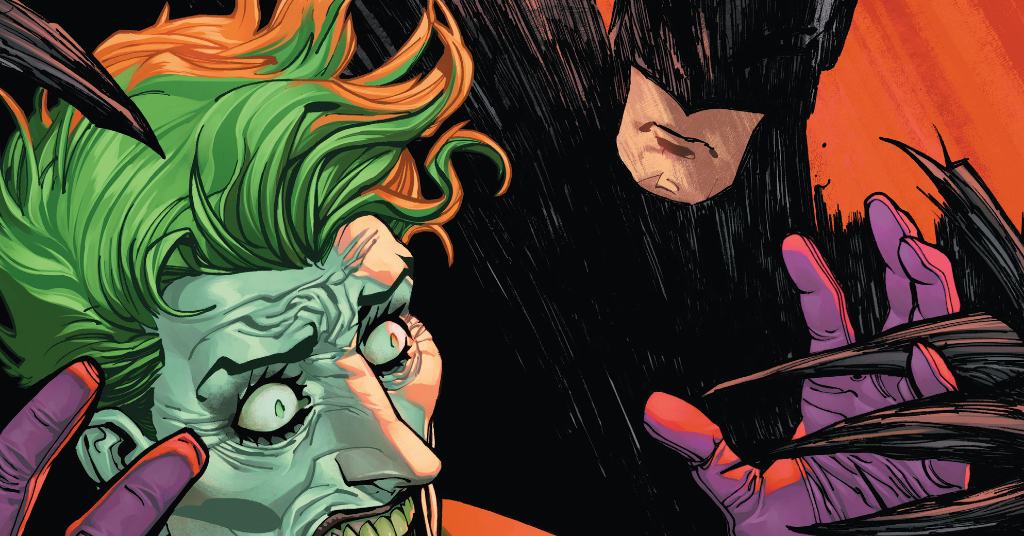Batman #143
Recap
THE JOKER YEAR ONE, PART TWO! The terrifying tale of "The Joker Year One" continues as a mysterious figure from Batman's past has come into Joker’s orbit, changing the Clown Prince of Crime forever! And what secrets does the re-formed Red Hood Gang have for Batman’s future?
Review
Batman #143 – written by Chip Zdarsky with pencils by Giuseppe Camuncoli and Andrea Sorrentino, inks from Stefano Nesi and Andrea Sorrentino, colors by Alejandro Sánchez and Dave Stewart, and lettering by Clayton Cowles – continues the exploration of Jokers past and present, splitting time between the early days and final moments of the clown prince of crime. In the past, Joker continues to find his way in a world after conversion from Red Hood to psychotic clown. In the future, circumstances come into focus as Joker infects Gotham with a sonic version of his infamous gas, twisting Gotham into a terrifying funhouse version of itself.
The writing for the issue continues to be a frustrating mixed bag, delivering interesting concepts while lacking strong execution. Zdarsky’s script pulls in a variety of sources and inspirations that range from Zero Year to Endgame (the Scott Snyder, Greg Capullo story arc), but none more so than Zdarsky’s own Batman: The Knight. That limited series feels like an essential part of his larger run, as the writer continues to weave Bruce Wayne’s mentors into key moments in the past and present. Like the use of references in Star Wars, it can help flesh out the world in the best circumstances but often makes everything feel small and artificial.
Including Daniel Captio as a secondary antagonist is a deft move by Zdarsky, and the weaving of his thirst for vengeance with an unformed Joker is a recipe for chaotic circumstances. Capito reveals his technique to nest personalities within one another, aka the underlying skill to create a Zur-En-Arrh. Capito works to train Joker while studying the acid-bathed villain, coming to realize three personas in the man. The revelation is a great bridging of continuity, building on and making the Geoff Johns/Jason Fabok idea more interesting.
The glaring flaw of these fascinating ideas is the inorganic way they are presented and introduced in the course of the story. It was established that Joker is telling this story to Batman in the present day, while locked up by Zur-En-Arrh. The interruption of the momentum from the present-day story gives this flashback a bitter taste and the inclusion of a future glimpse becomes incongruous. The placement in time also clashes with the natural points of the larger run. The idea of split personalities and Joker’s face-to-face with Zur-En-Arrh occurred in the first back-up of the series, post-Joker: Year One. A slight shifting of this story from the Zero Year era to after that back-up would make for a more logical trail of events, and create an organic reason to link these stories.
Just as the storytelling clashes, so too do the art styles in the issue. Camuncoli’s approximation of Greg Capullo’s time on Batman falls flat, reading with little vibrancy or moody atmosphere. There is a distinct lack of noir elements that could speak to the Joker’s perspective, yet instead seems like an incidental visual direction. The linework lacks the hyper-stylized approach of Jorge Jiménez or Leonardo Romero, instead settling for a vague resemblance of more interesting art styles and visual interpretation of the pulp-noir hero.
While Camuncoli’s art falls flat, Sorrentino’s stylings swing in the opposite direction, delivering some career-best art in the future sequences. The linework and coloring evoke Dave McKean in portions but with the appearance of Catwoman, the art shifts into a breathtaking style resembling watercolors. It’s a radical departure from the typical Sorrentino illustration and sells the overflowing love and emotion between the two characters. For a Batman who is getting worn down by the dark future created by the Joker, her appearance is a source of pure, beautiful inspiration. That visual language grounds the experience in Batman’s perspective, which is a frustrating layer to the storytelling.
Sorrentino’s beautiful artwork sings on the page thanks in part to the coloring, which adds an ethereal quality. Stewart’s coloring plays on the pastel tones that sell the warmth of the Bat/Cat relationship. It cuts straight through the moody, twisted atmosphere of the distant future for a few brief moments of respite. Once Joker gets his hooks into Catwoman’s mind, like the rest of the Batfamily, the book and Stewart’s colors revert to the sickly, inky blacks.
Final Thoughts
In the use of vastly different coloring, inconsistent art, and tepid writing, Batman #143 slightly improves on the previous issue without escaping from the story arc’s larger pitfalls. Zdarsky’s scripting connects interesting dots and for every strong idea, an equally bland story beat is employed. That uneven scripting is echoed in the illustrations for the issue, oscillating from the bland artwork by Camuncoli and the expressive linework by Sorrentino. With two issues down and one to go, little has inspired hope for a stuck landing for the story arc. One can hope Zdarsky can pull off the conclusion and tee up the modern-day plot, but based on these two issues, that hope is fleeting.
Batman #143: The Joker’s Zen
- Writing - 4/104/10
- Storyline - 3/103/10
- Art - 4/104/10
- Color - 4/104/10
- Cover Art - 2/102/10
